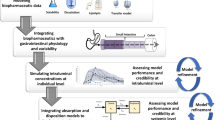Abstract
The emerging discipline of mathematical pharmacology occupies the space between advanced pharmacometrics and systems biology. A characteristic feature of the approach is application of advance mathematical methods to study the behavior of biological systems as described by mathematical (most often differential) equations. One of the early application of mathematical pharmacology (that was not called this name at the time) was formulation and investigation of the target-mediated drug disposition (TMDD) model and its approximations. The model was shown to be remarkably successful, not only in describing the observed data for drug–target interactions, but also in advancing the qualitative and quantitative understanding of those interactions and their role in pharmacokinetic and pharmacodynamic properties of biologics. The TMDD model in its original formulation describes the interaction of the drug that has one binding site with the target that also has only one binding site. Following the framework developed earlier for drugs with one-to-one binding, this work aims to describe a rigorous approach for working with similar systems and to apply it to drugs that bind to targets with two binding sites. The quasi-steady-state, quasi-equilibrium, irreversible binding, and Michaelis–Menten approximations of the model are also derived. These equations can be used, in particular, to predict concentrations of the partially bound target (RC). This could be clinically important if RC remains active and has slow internalization rate. In this case, introduction of the drug aimed to suppress target activity may lead to the opposite effect due to RC accumulation.






Similar content being viewed by others
References
Mager DE, Jusko WJ (2001) General pharmacokinetic model for drugs exhibiting target-mediated drug disposition. J Pharmacokinet Pharmacodyn 28:507–532
Mager DE, Krzyzanski W (2005) Quasi-equilibrium pharmacokinetic model for drugs exhibiting target-mediated drug disposition. Pharm Res 22(10):1589–1596
Gibiansky L, Gibiansky E, Kakkar T, Ma P (2008) Approximations of the target-mediated drug disposition model and identifiability of model parameters. J Pharmacokinet Pharmacodyn 35(5):573–591
Gibiansky L, Gibiansky E (2017) Target-mediated drug disposition model for drugs with two binding sites that bind to a target with one binding site. J Pharmacokinet Pharmacodyn. doi:10.1007/s10928-017-9533-1
Yan X, Krzyzanski W (2012) Dose correction for the Michaelis-Menten approximation of the target-mediated drug disposition model. J Pharmacokinet Pharmacodyn 39(2):141–146
Beal SL, Sheiner LB, Boeckmann AJ, Bauer R (eds) (1989–2014) NONMEM users guides. Icon Development Solutions, Ellicott City
Krippendorff BF, Kuester K, Kloft C, Huisinga W (2009) Nonlinear pharmacokinetics of therapeutic proteins resulting from receptor mediated endocytosis. J Pharmacokinet Pharmacodyn 36:239–260
Chakraborty A, Tannenbaum S, Rordorf C, Lowe PJ, Floch D, Gram H, Roy S (2012) Pharmacokinetic and pharmacodynamic properties of canakinumab, a human anti-interleukin-1β monoclonal antibody. Clin Pharmacokinet 51(6):e1–e18
Aston PJ, Derks G, Agoram BM, van der Graaf PH (2017) A mathematical analysis of rebound in a target-mediated drug disposition model: II. With feedback. J Math Biol 75(1):33–84. doi:10.1007/s00285-016-1073-6
Gibiansky L, Gibiansky E (2010) Target-mediated drug disposition model for drugs that bind to more than one target. J Pharmacokinet Pharmacodyn 37(4):323–346
Ma P (2012) Theoretical considerations of target-mediated drug disposition models: simplifications and approximations. J Pharm Res 29:866–882
Dua P, Hawkins E, van der Graaf PH (2015) A tutorial on target-mediated drug disposition (TMDD) models. CPT Pharmacomet Syst Pharmacol 4(6):324–337. doi:10.1002/psp4.41
Peletier LA, Gabrielsson J (2012) Dynamics of target-mediated drug disposition: characteristic profiles and parameter identification. J Pharmacokinet Pharmacodyn 39:429–451
Author information
Authors and Affiliations
Corresponding author
Rights and permissions
About this article
Cite this article
Gibiansky, L., Gibiansky, E. Mathematical description of drug–target interactions: application to biologics that bind to targets with two binding sites. J Pharmacokinet Pharmacodyn 45, 23–34 (2018). https://doi.org/10.1007/s10928-017-9546-9
Received:
Accepted:
Published:
Issue Date:
DOI: https://doi.org/10.1007/s10928-017-9546-9




